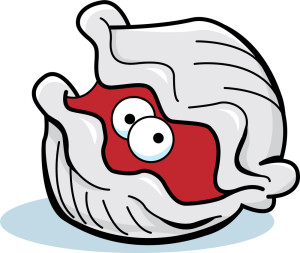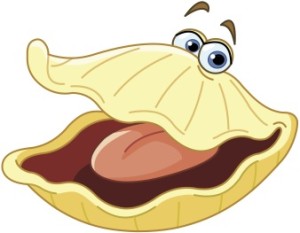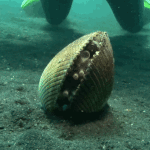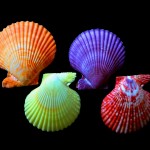Last week, a clam video went viral. (Get your mind out of the gutter, internet! I mean a bivalve! A mollusc! A lamellibranch!)
For people who know how clams actually live, the misconceptions of this video are obvious. That’s not the clam’s tongue, that’s its foot. The clam is trying to use its foot to burrow into the table and escape. (Here’s a video showing a clam using its foot to launch itself away from a predatory sea star (via Chris Mah), and here’s a video of a clam using its foot to burrow in the soft sea floor.) For people in the know, it can be easy to be scornful of a public so ignorant that they think clams lick salt. But that’s the wrong reaction.
First, it was perfectly reasonable for most people to think that this appendage was a tongue. Think about how bivalves are portrayed in cartoons. Here’s a bunch:



Yeah. They don’t have eyes, either.
Second, the “clam licking salt” video was a golden opportunity to teach a huge number of people a little bit about how invertebrates actually work. The video has been viewed over 1.7 million times – how often do that many people care about ANY aspect of ocean science? So when io9 contacted me to ask what was going on in the video, I was happy to talk to them. And when the io9 post lead to the Huffington Post and Daily Mail also contacting me for information, I talked to them too. Getting cool scientific information out to interested people is why we do this whole damn blog, after all. Here’s a selection of comments from the HuffPo piece:
Man, that looks freaking. I never saw anything like that before. WOW, Thumbs up. [link]
I have to say that was pretty gross but also pretty cool to watch [link]
Wow that’s interestingly creepy. :) [link]
awwwww.. it was looking for water and like the article said a anyplace but on a table with salt and no water. I tell you people …….More should read about the world around them and how it operates. People spent lifetimes to get that information to you [link]
I do feel a little ashamed about being the media point person for this story. After all, I haven’t “earned” it – while I do work with marine invertebrates, I am not a bivalve specialist. I had to resist to the urge to pass the journalists off to someone who really was a clam expert. I didn’t do so for two reasons: 1) I am sufficiently knowledgable to confidently address what was going on in this video, When I didn’t know the answer, like what species of clam was on the table, I simply said so. 2) Woody Allen said, “Eighty percent of success is showing up.” I was already talking to these journalists, and I wanted to get correct scientific information out to their readers. This is especially important for publications like the HuffPo and the Daily Mail, which are….not consistently focused on the best available science.
I encourage my fellow scientists to take advantage of opportunities like this. Viral videos about things like clam anatomy don’t come around every day – most people’s interest in clams begins with white wine and ends with butter. If this kind of opportunity comes your way, don’t be afraid to address it if you know the answer, even if it’s not your particular subspecialty. I’ll leave you with this inspirational and classic documentary on the importance of molluscs (make sure you make it to 2:45!):
Share the post "Secrets of the clam tongue: a case study in opportunistic science outreach"






I think the problem with mistakes like this is that however many people see it-that’s the first and ONLY thing they see. They don’t see the corrections or the subsequent “fixes”. Yes. They are teachable moments but those initial mistakes go a long way. A little knowledge is a dangerous thing.. :-)
I will say this though you did a good job with clarifying the problem description on the viral video. This came to the right person-someone who could explain the issue clearly without confusing it or overcomplicating it.
I don’t think you necessarily needed to be a bivalve specialist to explain this.. nor should you have any shame or “earned points”. You were the right person at the right time. So, take the compliment and feel good about this. You did a good job on it.
There’s actually some research that shows that starting with misconceptions can lead to more learning (in a classroom setting anyway). (ht @RockyRohde). Misconceptions can be a great starting point – but you’re right that it does depend on people actually listening a tiny bit longer. When reading the comments on those articles I was shocked to see a number of people say “DUH it’s a FOOT” which is of course exactly what the article itself said.
And thanks very much for the kind words below!
Kudos and you and to io9 for spreading the word about the foot.
I think being an academic for any significant period of time trains you to defer to the most authoritative source in all things. During the squid sperm kerfuffle, I kept thinking “But I’m not REALLY a squid sperm scientist, not like Jose and Henk-Jan.” But I know enough about it to educate people, and I made sure I gave those experts credit when I could. And in this case, like you said, you know enough about clams to tell the story straight. Well done, I say.
and another one that was mentioned at MerNetwork… a scallop “eating” a potato chip… poor fella.
http://www.buzzfeed.com/daves4/heres-a-clam-eating-potato-chips
Thanks for this. I got here after watching that video and googling “clam tongue”, so your point about misconceptions is very valid. I’d seen a clam reach toward food once when we were brought a live clam to put on a hibachi. I’ve always wondered how it knew there was food out there – and how it learned to like the broccoli it was reaching for!
Of course, the fact that it was trying to escape makes much more sense now. All I saw was a tongue reaching around, and because I thought I was seeing a tongue, I thought it was reaching around for food.
Poor clams.
Glad the post was helpful! If you were wondering, clams eat by filtering microscopic plants and animals out of the water using a straw-like appendage called a “siphon.” Their mouths are tiny and way inside their body. A clam couldn’t eat something as big as broccoli even if it wanted to.
Ugh.
Thank you! You also did a great job on the spermatophore story. Isn’t it funny that academia puts you in ever-tinier boxes, tinier than the normal world can POSSIBLY IMAGINE? I mean, how many people know that there ARE squid sperm scientific experts??? :)
Good post. Just to say that many bivalves do actually have eyes in reponse to ‘Yeah. They don’t have eyes, either.’, although not on their shells like in the cartoons admittedly. They are usually on the siphons or the mantle fringe exposed to the overlying water. The most famous examples being scallops which have quite complex eyes for a mollusc, its amazing! See…. ‘Gibson, R. N., Margaret Barnes, and R. J. A. Atkinson. “The evolution of eyes in the Bivalvia.” Oceanography and Marine Biology, An Annual Review, Volume 39: An Annual Review 39 (2001): 165-205.’.. for more on bivalve eyes.
Good post. Just to say that many bivalves do actually have eyes in response to ‘Yeah. They don’t have eyes, either.’, although not on their shells like in the cartoons admittedly. They are usually on the siphons or the mantle fringe exposed to the overlying water. The most famous examples being scallops which have quite complex eyes for a mollusc, its amazing! See…. ‘Gibson, R. N., Margaret Barnes, and R. J. A. Atkinson. “The evolution of eyes in the Bivalvia.” Oceanography and Marine Biology, An Annual Review, Volume 39: An Annual Review 39 (2001): 165-205.’.. for more on bivalve eyes.